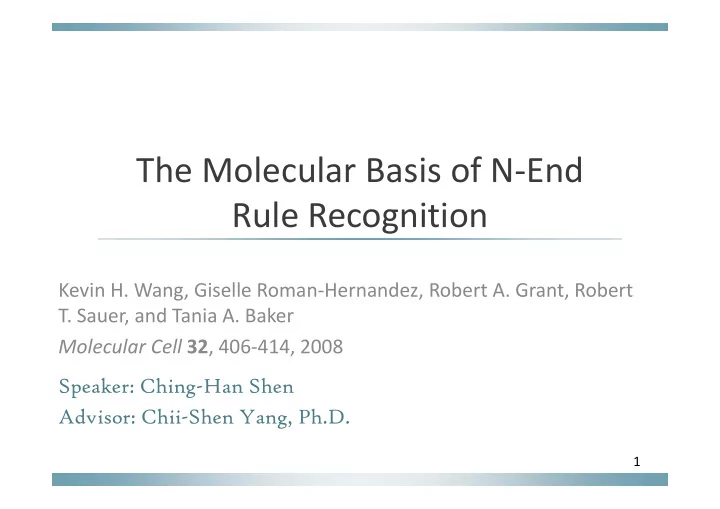

The Molecular Basis of N ‐ End Rule Recognition Kevin H. Wang, Giselle Roman ‐ Hernandez, Robert A. Grant, Robert T S T. Sauer, and Tania A. Baker d T i A B k Molecular Cell 32 , 406 ‐ 414, 2008 Speaker: Ching-Han Shen Advisor: Chii-Shen Yang, Ph.D. g 1
Protein degradation 2
2004 Protein quality control q y Stress response Proteaosome Cell cycle regulation 3
prokaryotes eukaryotes 4
N end rule in bacteria N ‐ end rule in bacteria Bulky hydrophobic residues (Phe, Leu, Trp, Tyr) � How to establish binding specificity? 5
ClpS cocrystal with N end rule peptide ClpS cocrystal with N ‐ end rule peptide � C. crescentus ClpS 35 ‐ 119 � C. crescentus ClpS 35 119 � Decapeptide with N ‐ terminal Tyr � Method: X ‐ ray diffraction M th d X diff ti � Resolution: 1.15 Å 6
ClpS recognizes the first residue ClpS recognizes the first residue The binding surfaces for the N ‐ end ‐ rule peptide and the ClpA N ‐ domain are Th bi di f f th N d l tid d th Cl A N d i � located on opposite sides Neither binding to a peptide substrate nor to the ClpA N ‐ domain appears to � change the ClpS’s conformation substantially ClpS recognizes the first residue of N ‐ end rule substrates 7 �
α NH3 + pins the side chain in place α ‐ NH3 pins the side chain in place N-terminal peptide 8
Bulky hydrophobic side chain fits into the specificity pocket a deep hydrophobic pocket a deep hydrophobic pocket N-end rule residues: Phe, Leu, Trp, Tyr 9
Where does the specificity come from Where does the specificity come from � α ‐ NH3 + pins the side chain in place � side chain fits into the specificity pocket � side chain fits into the specificity pocket To prove it further… � Conserved among evolution? � What happened when mutated? � What happened when mutated? 10
ClpS contact residues are highly conserved ClpS contact residues are highly conserved 8 bacteria, 1 plant, 2 eukaryotic E3 ligase. S Sequence homology suggests conserved recognition of N-end rule substrates. h l t d iti f N d l b t t 11
Mutate Asn34 His66 Asp36 in E coli Mutate Asn34, His66, Asp36 in E. coli Equivalent to Asn47 Asp49 His79 in Caulobacter Equivalent to Asn47, Asp49, His79 in Caulobacter 12
Mutations cause defect in ClpAP degradation Mutations cause defect in ClpAP degradation 13
Mutations compromise substrate recognition Mutations compromise substrate recognition Michaelis-Menten plot •Vmax: how fast the enzyme can go at full speed Vmax: how fast the enzyme can go at full speed •Km: how much substrate is required to get to full speed. 14
β chain clashes sterically with Met53 β ‐ chain clashes sterically with Met53 N-end rule residues: Phe, Leu, Trp, Tyr 15
Altered specificity mutation relieves restriction against Ile and Val (~ M53 in Caulobactor ) N-end rule residues: Phe, Leu, Trp, Tyr 16
Met 53 acts as a specificity gatekeeper Met 53 acts as a specificity gatekeeper N-end rule residues: Phe, Leu, Trp, Tyr 17
α -NH3 + pins the side chain in place ClpS recognizes the first residue p g Side chain fits into the specificity pocket Side chain fits into the specificity pocket of N-end rule substrates How to explain the specificity? Met 53 acts as a specificity gatekeeper Contact residues are functionally important 18
Thanks for your attention! y 19
Proteolysis in eukaryotes Proteolysis in eukaryotes 20
Proteolysis in prokaryotes Proteolysis in prokaryotes 21
ClpAS specificity ClpAS specificity 22
Recommend
More recommend